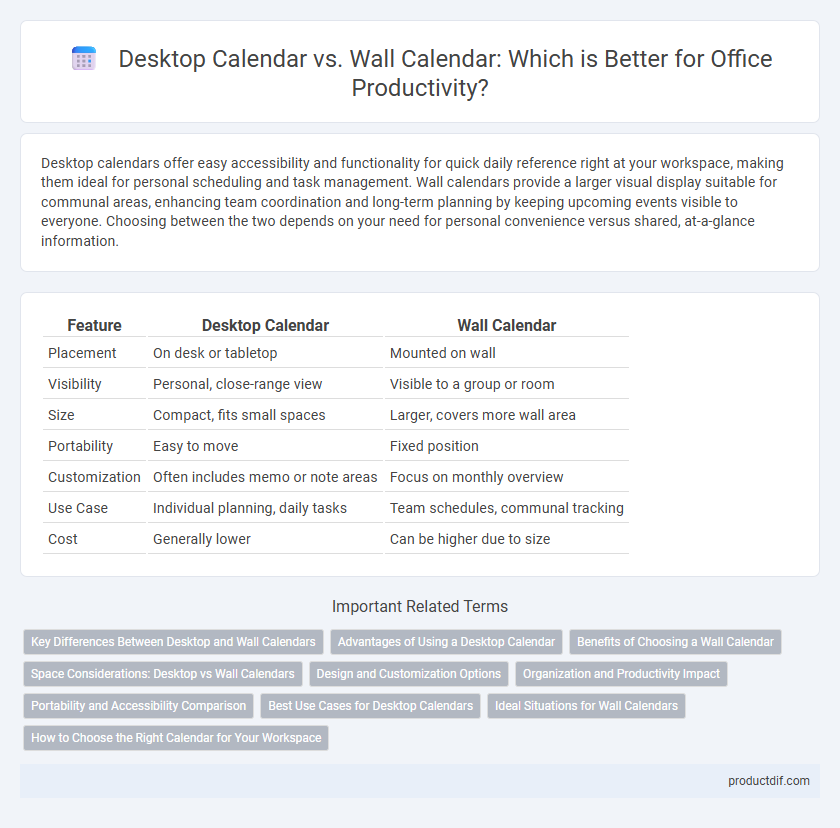Desktop calendars offer easy accessibility and functionality for quick daily reference right at your workspace, making them ideal for personal scheduling and task management. Wall calendars provide a larger visual display suitable for communal areas, enhancing team coordination and long-term planning by keeping upcoming events visible to everyone. Choosing between the two depends on your need for personal convenience versus shared, at-a-glance information.
Table of Comparison
| Feature | Desktop Calendar | Wall Calendar |
|---|---|---|
| Placement | On desk or tabletop | Mounted on wall |
| Visibility | Personal, close-range view | Visible to a group or room |
| Size | Compact, fits small spaces | Larger, covers more wall area |
| Portability | Easy to move | Fixed position |
| Customization | Often includes memo or note areas | Focus on monthly overview |
| Use Case | Individual planning, daily tasks | Team schedules, communal tracking |
| Cost | Generally lower | Can be higher due to size |
Key Differences Between Desktop and Wall Calendars
Desktop calendars offer portability and easy access on workspaces, making them ideal for quick date reference and note-taking during daily tasks. Wall calendars provide a larger display area suited for visual planning and group scheduling, often serving as a central organizational tool in offices. The key differences revolve around size, placement, and usability, where desktop calendars prioritize convenience and close proximity, while wall calendars emphasize visibility and communal use.
Advantages of Using a Desktop Calendar
A desktop calendar offers quick access and easy visibility during work hours, enhancing time management and productivity at the office. Unlike wall calendars, desktop calendars provide space for detailed daily notes and appointments, making scheduling more precise and personalized. Their compact size ensures they fit neatly on any workspace without clutter, contributing to an organized and efficient office environment.
Benefits of Choosing a Wall Calendar
Wall calendars offer a large, easily visible display that helps teams coordinate schedules and track important deadlines at a glance, enhancing office productivity. Their prominent placement reduces missed appointments and fosters better time management across departments. Wall calendars also save valuable desk space, keeping work areas organized and clutter-free.
Space Considerations: Desktop vs Wall Calendars
Desktop calendars maximize limited workspace by providing compact, easy-to-access date tracking without occupying wall space, ideal for crowded desks. Wall calendars save valuable desktop area and offer larger visual layouts, enhancing overview and planning for teams in shared office environments. Choosing between desktop and wall calendars depends on office layout, available space, and the need for personal versus group scheduling visibility.
Design and Customization Options
Desktop calendars offer compact, customizable designs with space for personalized branding, often featuring monthly views and integrated note sections ideal for individual use. Wall calendars provide larger display areas suitable for vibrant graphics and extensive customization, including seasonal imagery or promotional themes, enhancing brand visibility in office environments. Both types support tailored layouts and color schemes to align with corporate identity and enhance organizational efficiency.
Organization and Productivity Impact
Desktop calendars provide easy access and frequent visibility, enhancing daily organization and time management in office settings. Wall calendars offer a broader overview of monthly schedules, supporting team coordination and long-term planning. Both tools improve productivity by visually organizing tasks and deadlines, but desktop calendars promote immediate task tracking while wall calendars facilitate strategic scheduling.
Portability and Accessibility Comparison
Desktop calendars offer superior portability and can be easily moved between workspaces, making them ideal for on-the-go scheduling and personal reminders. Wall calendars provide constant accessibility and larger display space, which enhances visibility for group planning and long-term event tracking. Choosing between the two depends on the need for mobility versus a fixed, easily viewable reference in a shared environment.
Best Use Cases for Desktop Calendars
Desktop calendars are ideal for professionals who require quick, daily access to schedules and appointments without needing to consult wall space. Their compact size and portability make them perfect for crowded desks or small workspaces, providing easily visible date references during meetings or phone calls. Frequently updated and customizable layouts enhance productivity by keeping important deadlines and reminders front and center at individual workstations.
Ideal Situations for Wall Calendars
Wall calendars excel in environments requiring high visibility and easy accessibility for multiple users, such as conference rooms, break areas, or communal office spaces. They serve as effective tools for tracking project deadlines, team schedules, and important events at a glance, supporting collaborative planning and time management. Large formats and customizable layouts enhance their utility in coordinating group activities and ensuring everyone stays aligned.
How to Choose the Right Calendar for Your Workspace
Selecting the right calendar for your workspace depends on space availability and visibility preferences. Desktop calendars offer easy access and personal organization for individuals, ideal for small desks or personal offices, while wall calendars provide a broader overview for team planning and are best suited for shared spaces. Consider factors like size, layout, and glanceability to enhance productivity and ensure effective scheduling within your office environment.
Desktop Calendar vs Wall Calendar Infographic

 productdif.com
productdif.com